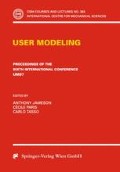Abstract
This paper describes the effective application of user modelling to the assessment of the physical ease with which a user can operate a standard QWERTY keyboard. The application is unusual in the sense that physical rather than cognitive skills are being modelled. The model examines four important skills which a user may have difficulty with, and produces an assessment of the ideal keyboard configuration for that user. This assessment can then be used to adapt the keyboard. For users with motor disabilities, such adaption can minimise or even eliminate the problems they experience. The model dynamically adapts to the current user and operates on free English text input. It has been evaluated using typing data from twenty keyboard users with disabilities and six without. The configuration recommendations made are very well matched to the users’ problem areas.
The authors acknowledge the support of the University of Edinburg in funding this research.
Access this chapter
Tax calculation will be finalised at checkout
Purchases are for personal use only
Preview
Unable to display preview. Download preview PDF.
References
Allen, R. (1990). User models: Theory, method and practice. International Journal of Man-Machine Studies 32:511–543.
Broadbent, S., and Curran, S. (1992). The Assessment, Disability and Technology Handbook. Oldham: North West Regional ACCESS Centre and Oldham Education Department.
Brown, J., and Burton, R. (1978). Diagnostic models for procedural bugs in basic mathematical skills. Cognitive Science 2:155–192.
Casali, S. (1995). A physical skills based strategy for choosing an appropriate interface method. In Edwards, A. D. N., ed., Extra-Ordinary Human-Computer Interaction: Interfaces for Users with Disabilities. Cambridge University Press. chapter 17, 315–341.
Clancey, W. (1987). Knowledge-Based Tutoring: The GUIDON Program. MIT Press.
Jameson, A. (1996). Numerical uncertainty management in user and student modeling: An overview of systems and issues. User Modeling and User-Adapted Interaction 5:193–251.
Kass, R., and Finin, T. (1988). A general user modelling facility. In Proceedings of Computer Human Interaction, 145–150. New York: ACM.
Kass, R., and Finin, T. (1989). The role of user rhodels in cooperative interactive systems. International Journal of Intelligent Systems 4:81–112.
Rich, E. (1983). Users are individuals: Individualising user models. International Journal of Man-Machine Studies 18:199–214.
Rich, E. (1989). Stereotypes and user modeling. In Kobsa, A., and Wahlster, W., eds., User Models in Dialog Systems. Berlin: Springer-Verlag. 35–51.
Self, J. (1988). Bypassing the intractable problem of student modelling. In Gauthier, G., and Frasson, C., eds., Proceedings of Intelligent Tutoring Systems ’88, 18–24.
Smutz, P., Serina, E., and Rempel, D. (1994). A system for evaluating the effect of keyboard design on force, posture, comfort and productivity. Ergonomics 37(10): 1649–1660.
Trewin, S., and Pain, H. (1996a). Keyboard and mouse errors due to motor disabilities. DAI research paper 838, AI Dept, University of Edinburgh. Submitted for publication.
Trewin, S., and Pain, H. (1996b). On the adequacy and uptake of keyboard access facilities for people with motor disabilities. DAI research paper 839, AI Dept, University of Edinburgh. Submitted for publication.
Webb, G., and Kuzmycz, M. (1996). Feature based modelling: A methodology for producing coherent, consistent, dynamically changing models of agents’ competencies. User Modeling and User-Adapted Interaction 5:117–150.
Author information
Authors and Affiliations
Editor information
Editors and Affiliations
Rights and permissions
Copyright information
© 1997 Springer-Verlag Wien
About this paper
Cite this paper
Trewin, S., Pain, H. (1997). Dynamic Modelling of Keyboard Skills: Supporting Users With Motor Disabilities. In: Jameson, A., Paris, C., Tasso, C. (eds) User Modeling. International Centre for Mechanical Sciences, vol 383. Springer, Vienna. https://doi.org/10.1007/978-3-7091-2670-7_16
Download citation
DOI: https://doi.org/10.1007/978-3-7091-2670-7_16
Publisher Name: Springer, Vienna
Print ISBN: 978-3-211-82906-6
Online ISBN: 978-3-7091-2670-7
eBook Packages: Springer Book Archive

